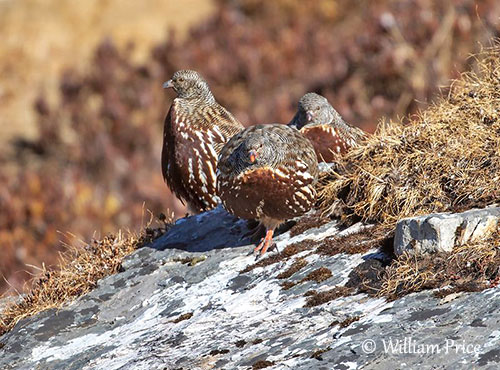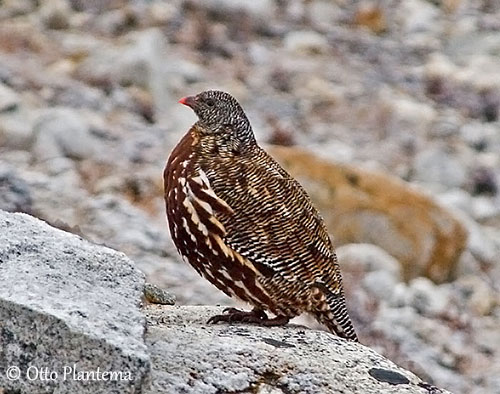
Fr: Lerva des neiges
Ang: Snow Partridge
All: Haldenhuhn
Esp: Perdiz Lerwa
Ita: Pernice delle nevi
Nd: Sneeuwpatrijs
Sd: sherpahöna
Photographers:
Otto Plantema
Trips around the world
William Price
PBase-tereksandpiper & Flickr William Price
Text by Nicole Bouglouan
Sources:
HANDBOOK OF THE BIRDS OF THE WORLD Vol 2 by Josep del Hoyo-Andrew Elliot-Jordi Sargatal - Lynx Edicions - ISBN: 8487334156
A Field Guide to the Birds of South-East Asia by Craig Robson. New Holland Publishers. ISBN: 9781780090498
Hennache, A. & Ottaviani, M. (2011). Cailles, Perdrix et Francolins de l'Ancien Monde, 400 pages. Editions W.P.A. France, Clères, France. ISBN 978-2-9512467-3-7
Biodiversity Heritage Library - New information on the Snow Partridge Lerwa lerwa (Hodgson 1833) and its systematic position
Post-breeding habitat association and occurrence of the Snow Partridge (Lerwa lerwa) on the Qinghai-Tibetan Plateau, west central China
Breeding Ecology of the Snow Partridge (Lerwa lerwa) in High-Altitude Regions, Tibet
How do Snow Partridge (Lerwa lerwa) and Tibetan Snowcock (Tetraogallus tibetanus) coexist in sympatry under high-elevation conditions on the Qinghai–Tibetan Plateau?
India Netzone - Snow Partridge, Indian Bird
Wikipedia, the free encyclopaedia
Snow Partridge
Lerwa lerwa
Galliformes Order – Phasianidae Family
INTRODUCTION:
The Snow Partridge is widely distributed at high elevations in the Himalayas, especially in India, Pakistan, Nepal and China.
The very cryptic plumage allows the birds to hide in the high-altitude habitat where rocks are covered with lichens.
The Snow Partridge feeds mainly on plant materials such as lichens, mosses and plant shoots, found in high grasslands and scrublands above the tree-line.
They are monogamous with lasting bonds, and are often found in pairs in spring. But they form flocks after the breeding season. The nest is placed on the ground. The young birds remain with their parents until the following breeding season.
The Snow Partridge has large range in which it is described as common, but the population is declining slowly, due to habitat loss and hunting. But for now, the species is not globally threatened.

DESCRIPTION OF THE BIRD:
Biometrics:
Length: 38-40 cm
Wright: M: 550-700 g – F: 450-580 g
The Snow Partridge is the only member of the genus Lerwa.
The bird appears dark greyish above. Head, neck and upperparts are heavily barred blackish and whitish, but we can see some dull chestnut on both scapulars and wing-coverts. Primaries and secondaries are brown. The tail is dark with white bars.
On the underparts, the area from lower breast to belly is chestnut with conspicuous white streaking merging into white vent, whereas undertail-coverts are vermiculated with chestnut. On the underwing, the whitish trailing edge to secondaries is well visible in flight.
Entire head and neck are barred blackish and whitish.
The curved bill, legs and feet are red. The tarsi are feathered on the front of the leg, half-way to the toes.
The eyes are brown, surrounded by buff eyering.
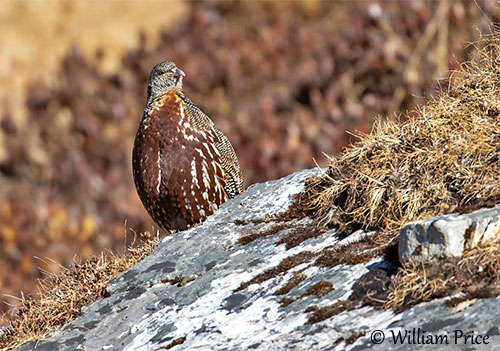
Male and female have similar plumage, but the female is slightly smaller than the male.
The juvenile resembles adult, but its plumage is rather finely spotted than barred on head and neck. The upper breast is finely barred rufous.
RANGE:
The Snow Partridge is found in the Himalayas, from Pakistan to Arunachal Pradesh along the higher range, between 3,000 and 5,000 metres of elevation, rarely below 2,000 metres.
It is resident in N Pakistan, NW, N and NE Indian Subcontinent, and S, SE and E Tibet, W China. In SW Asia, it is presumed resident in N Myanmar.
HABITAT:
The Snow Partridge is usually found in alpine pastures and open grassy hillsides with scattered vegetation including grass, moss, lichens, ferns and rhododendrons.
Unlike the Tibetan Snowcock which lives on stony or bare ground, the Snow Partridge is mainly found in small snow-patches. It is present at 3,000-5,000 metres of elevation.
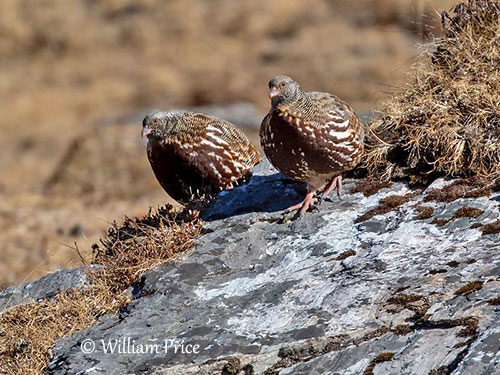
In SW China, it frequents all alpine habitats with exposed rocks and some vegetal cover such as lichens, sparse grass and herb. It also occurs in meadows with denser vegetal cover and among shrubby grasslands with various Salix species, and also in high-altitude Juniperus forests.
However, from some observations, suitable and predicted habitats for the Snow Partridge appear to be crests of mountain ridge lines, about 4,200 metres and more of elevation.
CALLS AND SONGS: SOUNDS BY XENO-CANTO
The Snow Partridge male’s territorial call is a loud, discordant and screechy whistled “skLEE’Er, skLEE’Er…” in which each note quickly drops away. They can be given singly or at more or less regular intervals.
We can also hear repeated, loud and slightly squeaky sounding whistles “jijiu, jijiu, jijiu” becoming faster and higher-pitched. The female gives softer and shorter calls declining in pitch.
When the birds are flushed, they give a repeated “huei, huei”.
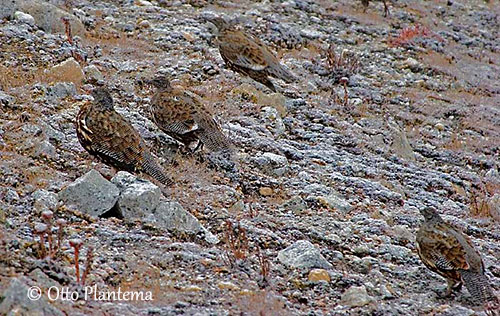
BEHAVIOUR IN THE WILD:
The Snow Partridge feeds mainly on mosses, lichens and shoots of plants. It is also known to swallow grit to aid the digestion.
In SW China, seeds, flowers, leaves and shoots of 43 plant species are recorded. It may also consume a small amount of animal food.
While foraging, the bird digs into the soil for food below the surface on the pyramidal peaks above 4,700 metres, along the ridges of steep rocky slopes at 4,350 metres, but not in shrubland areas.
The Snow Partridge usually forages in pairs or small groups of up to 10 individuals.
Up to 20-30 birds may gather at roosts. The roosting sites are located at pyramidal peaks and edges, above 4,600 metres of elevation.
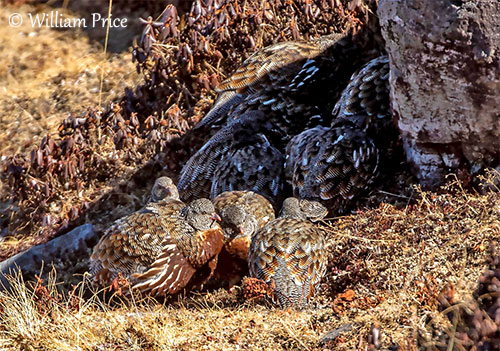
The Snow Partridge is well-adapted to the cold weather as it is living at high elevations. Even in summer, some patches of snow and occasional snow falls are recorded in the main habitats. During winter, the temperature varies between -10 and -25°C, with a minimum of about -40°C.
But this bird is naturally protected against the cold by the most feathered tarsi among all Phasianidae species. Between 42 and 55% of tarsus length is feathered, and even the recently hatched chicks have feathered tarsi. They also have feathers covering the nostrils. And in addition to this, they accumulate fat deposits in the autumn.
The Snow Partridge is monogamous and highly territorial. The courtship displays are poorly known because of the difficulty in seeing the birds. For these inhabitants of upper mountain slopes, the egg-laying begins in late April. The winter groups break prior to courtship and establishment of nest-sites. Both male and female may become aggressive and fights probably occur between pairs. The nest is built by the female.
The Snow Partridge may perform altitudinal movements in severe winters, descending to lower elevations between 2,100 and 2,700 metres.
In China, they remain above 3,800 metres, and no altitudinal movements are noted in Longmen Mts, SW China.
The flight of the Snow Partridge is rapid and stirring. In flight, the contrast between the dark primaries and secondaries and the narrow, white trailing edge is conspicuous.
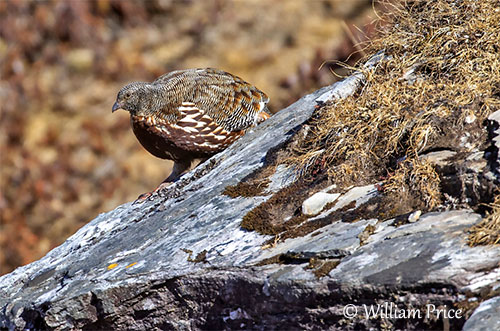
REPRODUCTION OF THIS SPECIES:
The breeding season takes place between May and July.
In monogamous species, the pair-bond may last, at least, for one whole breeding season. Both parents raise the young. The male may sometimes share the incubation with the female, or it stands guard while she is incubating.
The nest is a scrape or a hollow, placed on a hill-side on steep slope, or near a ridge line, protected by some rock, grass-tufts or bush. It is sometimes lined with moss or leaves, although unlined nests are occasionally recorded.
The female lays 3-5, sometimes up to 7 pale buff, yellowish-buff or grey-buff eggs with fine reddish markings. The duration of incubation and nesting periods are unknown, but the chicks leave the nest soon after hatching.
The contact calls with the young are soft, low notes, and the young respond with chicken-like cheep calls.
The adults may perform distraction displays to drive away predators.
PROTECTION / THREATS / STATUS:
The Snow Partridge is generally considered common where present in suitable habitat.
The species is threatened by habitat loss, caused by degradation and overexploitation.
In Longmen Mts, SW China, poaching and herb collection disturb the nesting birds.
In W Himalaya, it is affected by hunting pressure.
The population is roughly estimated at hundreds of thousands, but the high-altitude habitat does not allow correct estimation. This population is suspected to be declining slightly.
The species is present in several protected areas such as National Parks and Reserves.
The Snow Partridge is not considered globally threatened for now, and the species is currently evaluated as Least Concern.
